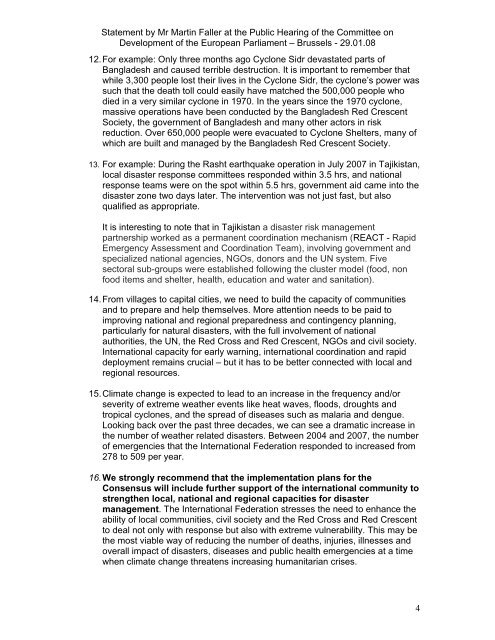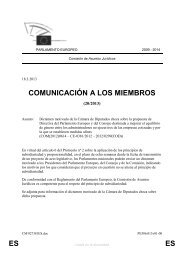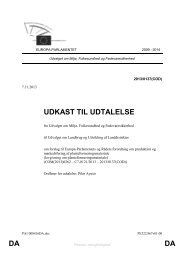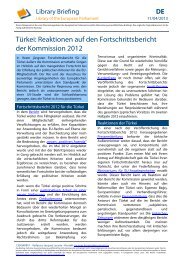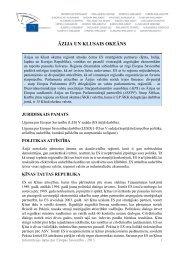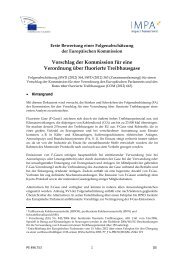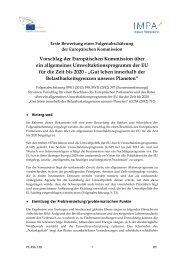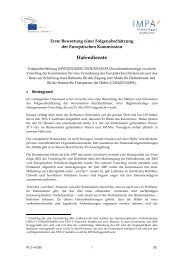Statement by Mr Martin Faller Head of Office Coordination and ...
Statement by Mr Martin Faller Head of Office Coordination and ...
Statement by Mr Martin Faller Head of Office Coordination and ...
Create successful ePaper yourself
Turn your PDF publications into a flip-book with our unique Google optimized e-Paper software.
<strong>Statement</strong> <strong>by</strong> <strong>Mr</strong> <strong>Martin</strong> <strong>Faller</strong> at the Public Hearing <strong>of</strong> the Committee on<br />
Development <strong>of</strong> the European Parliament – Brussels - 29.01.08<br />
12. For example: Only three months ago Cyclone Sidr devastated parts <strong>of</strong><br />
Bangladesh <strong>and</strong> caused terrible destruction. It is important to remember that<br />
while 3,300 people lost their lives in the Cyclone Sidr, the cyclone’s power was<br />
such that the death toll could easily have matched the 500,000 people who<br />
died in a very similar cyclone in 1970. In the years since the 1970 cyclone,<br />
massive operations have been conducted <strong>by</strong> the Bangladesh Red Crescent<br />
Society, the government <strong>of</strong> Bangladesh <strong>and</strong> many other actors in risk<br />
reduction. Over 650,000 people were evacuated to Cyclone Shelters, many <strong>of</strong><br />
which are built <strong>and</strong> managed <strong>by</strong> the Bangladesh Red Crescent Society.<br />
13. For example: During the Rasht earthquake operation in July 2007 in Tajikistan,<br />
local disaster response committees responded within 3.5 hrs, <strong>and</strong> national<br />
response teams were on the spot within 5.5 hrs, government aid came into the<br />
disaster zone two days later. The intervention was not just fast, but also<br />
qualified as appropriate.<br />
It is interesting to note that in Tajikistan a disaster risk management<br />
partnership worked as a permanent coordination mechanism (REACT - Rapid<br />
Emergency Assessment <strong>and</strong> <strong>Coordination</strong> Team), involving government <strong>and</strong><br />
specialized national agencies, NGOs, donors <strong>and</strong> the UN system. Five<br />
sectoral sub-groups were established following the cluster model (food, non<br />
food items <strong>and</strong> shelter, health, education <strong>and</strong> water <strong>and</strong> sanitation).<br />
14. From villages to capital cities, we need to build the capacity <strong>of</strong> communities<br />
<strong>and</strong> to prepare <strong>and</strong> help themselves. More attention needs to be paid to<br />
improving national <strong>and</strong> regional preparedness <strong>and</strong> contingency planning,<br />
particularly for natural disasters, with the full involvement <strong>of</strong> national<br />
authorities, the UN, the Red Cross <strong>and</strong> Red Crescent, NGOs <strong>and</strong> civil society.<br />
International capacity for early warning, international coordination <strong>and</strong> rapid<br />
deployment remains crucial – but it has to be better connected with local <strong>and</strong><br />
regional resources.<br />
15. Climate change is expected to lead to an increase in the frequency <strong>and</strong>/or<br />
severity <strong>of</strong> extreme weather events like heat waves, floods, droughts <strong>and</strong><br />
tropical cyclones, <strong>and</strong> the spread <strong>of</strong> diseases such as malaria <strong>and</strong> dengue.<br />
Looking back over the past three decades, we can see a dramatic increase in<br />
the number <strong>of</strong> weather related disasters. Between 2004 <strong>and</strong> 2007, the number<br />
<strong>of</strong> emergencies that the International Federation responded to increased from<br />
278 to 509 per year.<br />
16. We strongly recommend that the implementation plans for the<br />
Consensus will include further support <strong>of</strong> the international community to<br />
strengthen local, national <strong>and</strong> regional capacities for disaster<br />
management. The International Federation stresses the need to enhance the<br />
ability <strong>of</strong> local communities, civil society <strong>and</strong> the Red Cross <strong>and</strong> Red Crescent<br />
to deal not only with response but also with extreme vulnerability. This may be<br />
the most viable way <strong>of</strong> reducing the number <strong>of</strong> deaths, injuries, illnesses <strong>and</strong><br />
overall impact <strong>of</strong> disasters, diseases <strong>and</strong> public health emergencies at a time<br />
when climate change threatens increasing humanitarian crises.<br />
4


